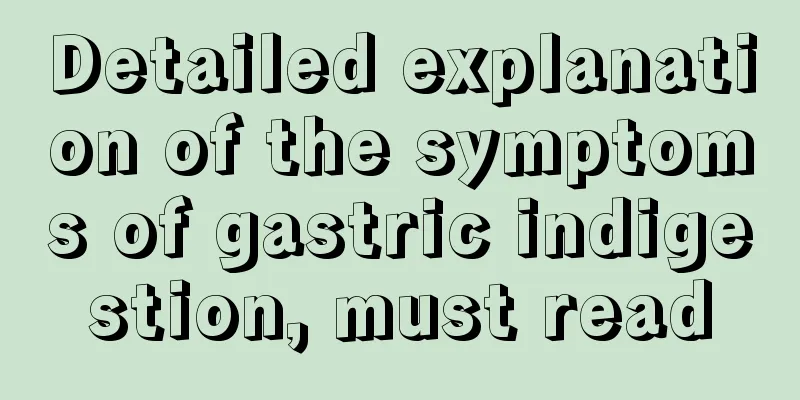Detailed explanation of the symptoms of gastric indigestion, must read

|
Many people have experienced gastric indigestion in their lives, and the symptoms vary slightly depending on the severity of the disease. Short-term indigestion symptoms may go away after a while, but if they persist for a long time, you should pay more attention to it. So what are the specific symptoms of gastric indigestion? 1. Early satiety, bloating, and belching Early satiety, abdominal distension, and belching are common symptoms, which may occur alone or in a group, with or without abdominal pain. Early satiety refers to a feeling of fullness shortly after eating, resulting in a significant reduction in food intake. Upper abdominal distension often occurs after meals, or persists and worsens after meals. Early fullness and epigastric distension are frequent with belching. 2. Upper abdominal pain Upper abdominal pain is also a common symptom. Some patients have upper abdominal pain as the main symptom, with or without other upper abdominal symptoms. Upper abdominal pain is often irregular. In some patients, upper abdominal pain is related to eating, manifesting as fullness pain, which is relieved after eating, or persisting between 0.5-3.0 hours after a meal. 3. Functional dyspepsia Anyone who has the above-mentioned indigestion symptoms but has no definite organic disease to explain it is called functional dyspepsia. This type of indigestion has the highest incidence and most people have experienced it. The main causes of the disease are related to mental and psychological factors, such as mood swings, sleep status, poor rest, stimulation from tobacco and alcohol, etc. Depending on the symptoms, it can be divided into the following types: (1) Ulcer-like dyspepsia type, which is characterized by symptoms of peptic ulcer without the presence of ulcer. Recent studies have found that patients who are often faced with stress may have a stress reaction, with intermittent increase in gastric acid excretion. In addition, motility disorders prolong and increase the damage of gastric acid to the mucosa. Therefore, patients with this type may improve by eating or taking H-receptor antagonists. (2) Dysmotility-like dyspepsia type, which is characterized by clinical manifestations of gastric retention symptoms. Patients have difficult-to-localize upper abdominal pain or discomfort, which is often caused by eating or aggravated after meals. At the same time, they also have upper abdominal distension after meals, early satiety, nausea or vomiting, and poor appetite. (3) Specific dyspepsia type: patients with FD symptoms but not meeting the above two groups of characteristic dyspepsia. (4) Organic dyspepsia: After examination, it can be clearly determined that the dyspepsia symptoms are caused by a disease in a certain organ, such as liver disease, bile duct disease, pancreatic disease, diabetes, etc. For these patients, treatment is mainly targeted at the cause, with auxiliary supplementation of digestive enzymes or improvement of gastric motility to relieve indigestion symptoms. |
<<: The efficacy and function of black sesame, nourishing the skin and losing weight
Recommend
Why are the leaves of Milan always yellow? What should I do if the leaves of Milan turn yellow?
Milan is a common flower in life. Many people lik...
What is the best treatment for uterine prolapse?
What is the best treatment for uterine prolapse? ...
What causes uterine fibroids?
Uterine fibroids are also a common type of uterin...
Why do I have frequent urination after a cesarean section?
Many pregnant women eventually choose cesarean se...
Rest of World: In March 2025, Xiaohongshu's daily active users in the United States will reach 800,000 and its global daily active users will reach 6.1 million
Recently, Rest of World published an article that...
Causes of blood clots during menstruation
We know that female friends need to pay special a...
Women sweat on their chest while sleeping at night
Normally, the back and neck of the body are prone...
What is the name of Wu Bai's song "Want to See You"? Is Wu Bai's song "Want to See You" in the Taiwanese drama "Crossing the Fuse"?
How many people watched the Taiwanese drama "...
What are the chemotherapy treatments for ovarian granulosa cell tumors?
Ovarian granulosa cell tumor is the most common o...
IDC: India's tablet shipments to grow 42.8% year-on-year in 2024
According to the latest data from IDC's Globa...
Can albumin cure all diseases and improve immunity? Pharmacist reminds: Don't use it wrongly
Huazi just rejected a friend's request becaus...
Why do pregnant women get hemorrhoids?
Many female friends will have varying degrees of ...
Precautions for vaginitis during menstruation
The characteristic of vaginitis is that although ...
How long should you weigh yourself?
Many people like to weigh themselves when they ar...
Is it better to install warm white or pure white downlight in the living room? What light source is better for downlight in the living room?
We all know that the choice of light source in th...









